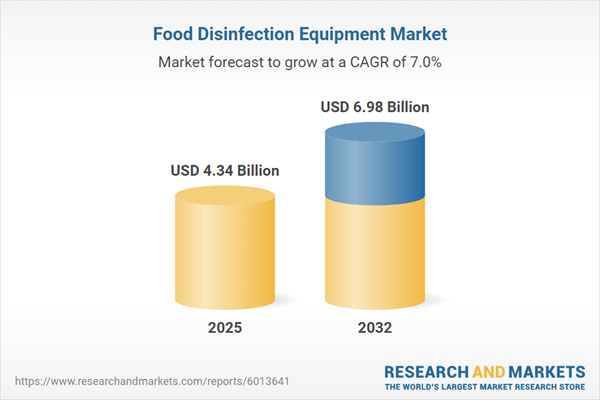Speak directly to the analyst to clarify any post sales queries you may have.
The food disinfection equipment market is experiencing significant transformation as organizations focus on compliance, operational excellence, and maintaining robust supply chains. Leadership teams are prioritizing advanced solutions and innovation to safeguard product integrity and align with evolving global standards.
Market Snapshot: Food Disinfection Equipment Market Growth and Trends
The global food disinfection equipment market is projected to grow from USD 4.05 billion in 2024 to USD 4.34 billion in 2025, with a compound annual growth rate (CAGR) of 7.03%, and is forecast to reach USD 6.98 billion by 2032. This trajectory is driven by stringent food safety regulations, rising demand for clean-label products, and the need for improved compliance standards. Companies are refining sourcing tactics, leveraging new technologies to improve transparency, and focusing on production optimization. Current market leaders are responding to higher safety thresholds in key regions by differentiating their operations through compliance, technology adoption, and increased clarity in production processes to meet both client and regulatory expectations.
Scope & Segmentation: Competitive Segments and Regional Dynamics
- Technologies: Chlorine dioxide systems, ultraviolet light equipment, steam-based devices, pulsed light technology, and ozone gas generators enable facilities to tailor disinfection protocols to specific compliance requirements and adapt across various production scales.
- Equipment Types: Batch systems, cabinet units, conveyor-based machines, and tunnel equipment support flexible throughput and allow organizations to configure layouts and flows according to operational goals.
- Applications: Solutions address needs in dairy processing, fresh produce, meat and poultry, seafood, and packaged foods, integrating seamlessly across the supply chain to enhance traceability and lower contamination risks.
- End Users: Food and beverage manufacturers, contract processors, retailers, and restaurant operators each require specialized disinfection solutions aligned with their distinct regulatory and operational environments, directly impacting procurement and workflow decisions.
- Distribution Channels: Equipment reaches users via aftermarket partners, direct sales, distributors, and e-commerce platforms, all supporting consistent sourcing and ongoing asset management through the equipment lifecycle.
- Regional Coverage: The market reflects diverse regulatory frameworks and technology uptake across the Americas, Europe, Middle East, major African regulatory hubs, and Asia-Pacific, guiding decisions on procurement, compliance, and long-term investments.
- Key Players: Ecolab Inc., Tetra Pak International S.A., JBT Corporation, Bühler AG, Marel hf., Alfa Laval AB, Pentair plc, Hiperbaric S.L., Amandus Kahl GmbH & Co. KG, and Aqua Ultraviolet, LLC serve as principal industry providers, shaping solutions and best practices worldwide.
Key Takeaways for Senior Decision Makers
- Organizations are integrating sustainable, non-chemical, and hybrid disinfection solutions to support environmental objectives and achieve regulatory approval in different markets.
- Advancements in automation and integrated analytics now provide real-time monitoring and support swift, data-driven decision-making with consistency across multiple production environments.
- Agile adaptation of technology and operating models is ensuring compliance with local and international standards, while also enhancing competitiveness amid regulatory change.
- Collaboration between industry manufacturers, research institutions, and specialized partners is broadening technology choices and enabling rapid alignment with evolving client needs.
- Adoption of digital procurement and modular equipment strategies is enhancing asset utilization, improving reliability, and lowering operational costs over the product lifespan.
Tariff Impact on Procurement and Operations
Recent U.S. tariffs on imported components have led North American companies to revise procurement structures and operational processes. Leadership teams are emphasizing regional sourcing, investing in local assembly partnerships, and diversifying supply networks. Establishing robust contract mechanisms and extending vendor agreements are proving critical for sustaining supply chain reliability and navigating regulatory shifts.
Methodology & Data Sources
This analysis combines structured executive interviews with thorough review of regulatory and technical documents, and evaluation of global data sets. Subject matter experts validate all insights, ensuring relevance and accuracy for senior decision makers.
Why This Report Matters
- Guides leaders in refining procurement, investment, and operational strategies by aligning with rapid technological evolution and shifting compliance requirements in the food disinfection equipment sector.
- Provides actionable recommendations to streamline efficiency, ensure compliance, and optimize resource allocation for organizations navigating complex market changes.
- Delivers focused, practical insights on cost control and risk management, supporting resilience and adaptability to varying market and regulatory contexts.
Conclusion
This report equips senior leaders with strategic perspectives to inform decisions on technology, partnerships, and operational models. Comprehensive analysis supports organizations as they anticipate industry developments and sustain strong, responsive market positions.
Additional Product Information:
- Purchase of this report includes 1 year online access with quarterly updates.
- This report can be updated on request. Please contact our Customer Experience team using the Ask a Question widget on our website.
Table of Contents
3. Executive Summary
4. Market Overview
7. Cumulative Impact of Artificial Intelligence 2025
Companies Mentioned
The companies profiled in this Food Disinfection Equipment market report include:- Ecolab Inc.
- Tetra Pak International S.A.
- JBT Corporation
- Bühler AG
- Marel hf.
- Alfa Laval AB
- Pentair PLC
- Hiperbaric S.L.
- Amandus Kahl GmbH & Co. KG
- Aqua Ultraviolet, LLC
Table Information
| Report Attribute | Details |
|---|---|
| No. of Pages | 197 |
| Published | November 2025 |
| Forecast Period | 2025 - 2032 |
| Estimated Market Value ( USD | $ 4.34 Billion |
| Forecasted Market Value ( USD | $ 6.98 Billion |
| Compound Annual Growth Rate | 7.0% |
| Regions Covered | Global |
| No. of Companies Mentioned | 11 |









